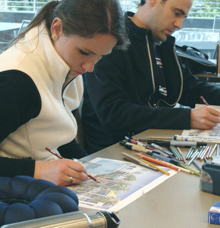Workshop FAQ’s

1. Who takes these drawing workshops and why?
Mostly students, teachers and practicing professionals in the field of architecture and landscape architecture. The workshop is designed for all skill levels, but a basic knowledge of how to use Adobe Photoshop, Google SketchUp and reprographics (scanning and printing) is desirable.
2. What can I expect to learn in the workshop?
About 25% of the workshop covers traditional drawing tools and techniques (color markers, pencils and pens), 25% how to draw people, trees and entourage, 25% basic overlay and trace drawing method and 25% new hybrid drawing methods that integrate traditional hand drawing with new digital imaging.
3. How much does a workshop cost?
Workshop registration varies slightly depending on who is sponsoring the workshop, location and length of the program.
4. What is a typical workshop daily schedule?
Single and multiple day workshops are typically divided into “blocks”, each lasting 2 hours and covering a specific drawing topics. Workshops move quickly and are designed to offer the maximum of content in a very short time period.
5. What is Jim Leggitt’s teaching method?
Jim uses an overhead high definition video camera above his work surface and his drawing demonstrations are projected onto a large screen for all to see. Everyone “draws along with Jim” using this highly effective and often entertaining video projection method.
6. What materials should I bring to the workshop?
Participants must bring their own drawing supplies that include basic colored markers, colored pencils, drawing pens, tracing paper, tape, straight edge or triangle and other items listed on the recommended materials list posted on Jim’s website www.drawingshortcuts.com
7. Do I need to bring a laptop to the workshop?
You do not need to bring a laptop to the workshop.
8. What 2D/3D computer skills are needed to take a workshop?
The workshop not only covers traditional drawing tools and techniques, but focuses on new ways to integrate current digital technology into the visualization process. It is highly recommended that you have a basic working knowledge of software programs such as Adobe Photoshop, Adobe InDesign, SketchUp and know how to scan drawings and print drawings using standard 3-in-1 printer/scanner/copy machines.
Workshop Frequently Asked Questions




